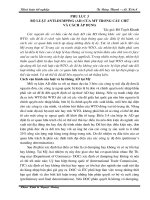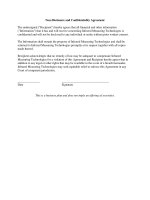Non marine evidence
Bạn đang xem bản rút gọn của tài liệu. Xem và tải ngay bản đầy đủ của tài liệu tại đây (2.04 MB, 44 trang )
Non-marine Evidence
Chapter 7
Loess
• Loess: wind-blown deposit comprised
predominantly of silt-size particles (20-60
µm).
• Loess deposits cover ~10% of the surface of
the planet. They are up to ~300 m in
thickness in China.
• Loess deposits typically exhibit varying
stages of soil development.
www.gogeek.org/ ~glothar/geo304/pix.html
Loess deposits-development
• Related to four events:
–
–
–
–
Formation
Transport
Deposition
Post-depositional changes
Loess deposits-development
• Formation
– Metamorphic rocks have silt-size minerals that
are expelled during erosion.
– Weathering and soil formation fracture coarse
grains, creating silt particles.
– Transformation of clay particles can produce
silt-size minerals.
– Glacial grinding, eolian abrasion, frost
weathering, salt weathering.
Formation of loess deposits
Pre-glacial weathering
Glacial Erosion
Production of unsorted sediments
Transport by streams or debris
Transport by glaciers
Further particle size reduction
Deposition of mixed sediment size
Removal of fine silt and clay by winds
Aeolian abrasion and particle size reduction
Medium to coarse silt transported
for short distances in suspension
LOESS deposits
Fine silt and clay transported
for long distances in suspension
Widely dispersed dust
After Wright, 2001
Loess deposits-development
• Transport/Deposition
– Wind (streams?)
• Strength
• Direction
• Vegetation
• Post-depositional changes
– Soil formation
•
•
•
•
Temperature
Rainfall
Slope
Vegetation
Loess deposits-Chronology
•
•
•
•
Radiocarbon
Optical luminescence
Magneto-stratigraphy
Correlation (marine
isotope record).
Loess deposits-Paleoclimate
• Grain size (wind
direction/strength).
• Soil type (vegetation,
rainfall).
• Magnetic susceptibility
(source and postdepositional changes).
• Pollen (vegetation).
• Land snails (temperature,
rainfall).
From Xiao et al., 1995)
Changes in Magnetic
Susceptibility
• Relative enrichment of magnetic minerals due
carbonate leaching. (BUT it only accounts for a small
increase).
• Diluting effect by influx of weak magnetic
minerals. (BUT believed to be insignificant).
• Pedogenic formation of magnetic minerals.
• Variable sources of magnetic minerals.
• Ultra-fine magnetic particles produced from
decomposition of vegetation. (BUT its significance is
unknown).
• Frequent fires in loess.
(BUT no evidence of frequent fires).
Studies on modern soils show a
positive relationship between
magnetic susceptibility (MS)and
mean annual temperature (MAT)
and precipitation (MAP).
Porter et al., 2001
0 ka
~21 ka
~24 ka
~30-50 ka
~135 ka
Loess–paleosol sequence at Thebes, Illinois
Grimley et al., 2003









